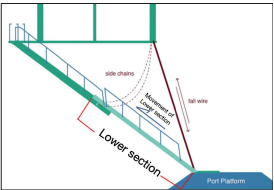202340 - Accommodation ladder not accommodating
A vessel was about to leave port. Once the pilot had boarded, crew began to secure the accommodation ladder for sea passage.
As edited from TAIC (New Zealand) report MO-2021-205
This ladder was of ‘telescopic’ design, such that the lower half was able to slide inside the upper half for securing. Although of a Class approved design and SOLAS compliant, the practical considerations of using this particular type of ladder were complicated.
A previous incident had led to a risk assessment that identified the entire upper section as a ‘dangerous area’ while the ladder was being retracted. As a result of this risk assessment, the company had established a procedure that no person should stand in that area during securing operations. However, it appears this was routinely violated, as in this instance.
The inboard handrail side chain became caught between the sliding lower ladder and the fixed upper ladder, and a crewmember stepped onto the upper ladder to free it. Once he had cleared the inboard handrail chain, he picked up the outboard handrail chain and held onto both to prevent them from getting caught again. Holding both chains, he stood on a step close to the top of the fixed ladder, but within the area identified as dangerous from the previous incident.
On board, another crewmember resumed heaving on the fall wire to retract the lower section of accommodation ladder. As this was proceeding, the ladder end dropped off the port platform. Because the side chains were slack and not supporting the fixed upper ladder, the weight was transferred from the dock platform and onto the fall wire. This resulted in an unexpected and uncontrolled upward movement of the lower ladder.
The sudden upward movement of the lower ladder trapped the victim’s left leg between the top step of the lower ladder and the third step of the fixed upper ladder. All work stopped immediately, and the crew wedged timber between the steps to ease the weight on the victim’s leg and prevent further injury. It was decided that the safest option to free the victim’s leg was to cut the step. This was accomplished, and at the same time the first responders boarded the vessel and brought the victim to hospital.

Lessons learned
- Each close call, incident or accident is an opportunity to improve safety by analysing the events and implementing mitigating measures such as new procedures or engineering solutions. To be fully effective, the new procedures should be followed.
- Don’t let your ‘Can Do’ attitude lead you into a dangerous position, as with the victim in this accident. Follow the established procedure.
